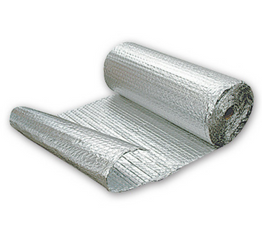
Discover the uses and benefits of bubble insulation with Alfatherm
What is Bubble Insulation Used For? Exploring the Benefits of Alfatherm Insulation
Bubble insulation is a versatile solution offered by Alfatherm Insulation, designed to enhance energy efficiency in residential and commercial buildings. This type of insulation consists of layers of air bubbles sandwiched between reflective layers. This unique design helps in creating a barrier that reduces heat transfer, keeping interiors cooler in summer and warmer in winter.
What is Bubble Insulation Used For?
Bubble insulation, also known as bubble wrap insulation, is a versatile material used in various applications across industries and residential settings. Its unique design consists of multiple layers of bubble air pockets sandwiched between reflective surfaces, typically made from aluminum foil or plastic films. This construction gives bubble insulation several beneficial properties that make it suitable for a range of uses:
1. Thermal Insulation:
Bubble insulation is primarily used for thermal insulation purposes. The air pockets within the material provide a barrier against heat transfer by reducing radiant heat gain or loss. This makes it effective in both hot and cold climates, helping to maintain stable indoor temperatures and reduce energy consumption.
2. Building and Construction:
In the construction industry, bubble insulation is often installed in walls, roofs, floors, and crawl spaces. It enhances the thermal efficiency of buildings by reflecting radiant heat away from the interior during summer and trapping heat inside during winter. It can also act as a vapor barrier in certain applications.
3. Packaging and Shipping:
Bubble wrap insulation’s cushioning properties make it ideal for packaging fragile items during shipping. It protects goods from impact damage and provides thermal insulation to prevent temperature fluctuations that could affect sensitive products like electronics, pharmaceuticals, and food items.
4. Greenhouses and Agricultural Use:
In agriculture and horticulture, bubble insulation is used in greenhouses to regulate temperature and protect plants from extreme weather conditions. It helps maintain a stable microclimate by reducing heat loss at night and minimizing overheating during the day.
5. Soundproofing and Acoustic Insulation:
The air pockets in bubble insulation also contribute to soundproofing properties. When installed in walls, ceilings, or floors, it can help reduce noise transmission between rooms or from external sources, improving acoustic comfort in residential and commercial buildings.
6. DIY Projects and Home Improvement:
Due to its lightweight and easy installation, bubble insulation is popular for DIY projects and home improvements. It can be cut to size and applied to windows, doors, water heaters, and HVAC ducts to improve energy efficiency and comfort levels within homes.
7. Automotive and Transportation:
In vehicles, bubble insulation is used to reduce heat transfer through car doors, roofs, and engine compartments. This improves cabin comfort by stabilizing interior temperatures and reducing the workload on air conditioning systems.

Benefits of Bubble Insulation
High Thermal Performance: One of the primary advantages of bubble insulation is its excellent thermal performance. The air bubbles trapped within the material create a barrier that significantly reduces heat transfer. This property helps maintain indoor temperatures, keeping spaces cooler in summer and warmer in winter.
Reflective Properties: Bubble insulation often incorporates reflective surfaces that can reflect radiant heat away from the building. This feature is particularly beneficial in hot climates where reducing solar heat gain can lead to substantial energy savings on cooling costs.
Lightweight and Flexible: Unlike traditional insulation materials, bubble insulation is lightweight and flexible. This makes it easier to handle during installation, especially in tight or irregular spaces where rigid materials may be difficult to fit.
Moisture Resistance: Properly installed bubble insulation can act as a moisture barrier, helping to prevent condensation within walls and ceilings. This moisture resistance not only protects the building structure but also contributes to indoor air quality by reducing the risk of mold and mildew growth.
Sound Insulation: In addition to thermal benefits, bubble insulation also provides sound insulation properties. The air pockets within the material help absorb and dampen sound vibrations, creating a quieter and more comfortable indoor environment.
Environmentally Friendly: Many types of bubble insulation are manufactured using recyclable materials, making them a sustainable choice for environmentally conscious builders and homeowners.
Why Choose Alfatherm Insulation?
Alfatherm Insulation stands out in the market for its commitment to quality and innovation. As a trusted provider of bubble insulation solutions, Alfatherm combines cutting-edge technology with rigorous testing to deliver products that meet the highest standards of performance and reliability. Whether you’re renovating an existing home or constructing a new building, Alfatherm Insulation offers solutions that enhance comfort, reduce energy consumption, and promote sustainability.
Conclusion
In conclusion, bubble insulation offered by Alfatherm Insulation is a versatile and effective choice for enhancing the thermal efficiency of buildings. With its ability to provide superior insulation, moisture resistance, and soundproofing properties, bubble insulation not only improves comfort but also helps to reduce energy costs and environmental impact. Consider Alfatherm Insulation for your next insulation project and experience the difference in comfort and energy savings.
FAQ
Bubble insulation works by trapping air within its bubbles and reflecting radiant heat, thus reducing heat transfer.
It can be installed in attics, walls, crawl spaces, and under floors, enhancing thermal insulation in various parts of a building.
Yes, bubble insulation helps in reducing energy consumption, which contributes to lower carbon emissions.
Bubble insulation is versatile and can be used in various applications such as roofs, walls, floors, and HVAC ducts. It is suitable for both residential and commercial buildings to enhance thermal performance.
Installing bubble insulation involves cutting the material to fit the desired area, ensuring a snug fit without gaps. It can be stapled, taped, or glued into place depending on the application. Proper installation ensures optimal performance of the insulation.

0 comments